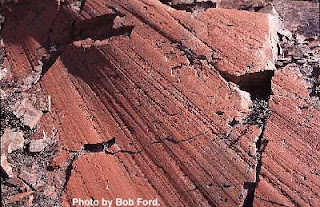Glacier National Park is full of many different types of glacial erosion. This entry will focus on the evidence of scouring, plucking, cirques, horns, and aretes. All of these forms of erosion help create the unique and beautiful mountains and valleys of Glacier National Park.
The first form of erosion that I will discuss is scouring. Scouring is a process in which sediments are dragged or washed across a rock face leaving different sized scratches in the surface of the rock. Sediments that are not attached to the rock surface are transported across by the glacial water that is melted and flowing down the mountain between the layers of glacial ice and the rock face. This process can leave long and narrow scratches known as striations. It can also leave extremely smooth rock surfaces depending on the width of the debris flow.
This is an example of a rock surface that is now smooth from scouring.
The second form of erosion that is very similar to scouring is known as plucking. Plucking is a process in which glacial water freezes in the cracks on a rock surface. As the glacial ice begins to move along the side of the mountain the materials, typically rock and soil sediments, are pulled and plucked out of the rock surface.
When plucking and scouring both occur you find rock features that are smooth on one side, where the scouring occurred, and jagged on the side that the plucking occurred.
The natural movement of glaciers is what leads to glacial erosion. Plucking and scouring are both a type of glacial erosion but their are also distinctive land features associated with glacial erosion. Some of these distinctive features are known as cirques, horns, and aretes. Cirques are the more common physical features of glacial erosion on mountain faces. Cirques are a bowl shaped depression caused from the downward and outward movement of glaciers.
This is Iceberg Cirque in Glacier National Park. Notice how the mountain face is a semicircular depression, very similar to what a half of a cereal bowl would look like. Its as if someone were to come in and take half of an ice cream scoop out of the mountain.
Cirques can form other features such as horns and aretes. Horns are pyramid like peaks created from cirques chiseling away three or more sides of a mountain. This leaves mountains that could have once been a rounded mountain top looking like a peak with three or more bowl shaped depressions forming a pointed top. Aretes are formed when two cirques erode a mountain side by side leaving what appears to be a spine like rock figure separating the two cirques.
References
http://www.hartimages.com/photo_9923048.html
http://www.eoearth.org/article/Glacial_landforms?topic=50013
http://libwiki.mcmaster.ca/clip/index.php/Main/RocheMoutonnee





How long does it take for erosion too be evident
ReplyDelete